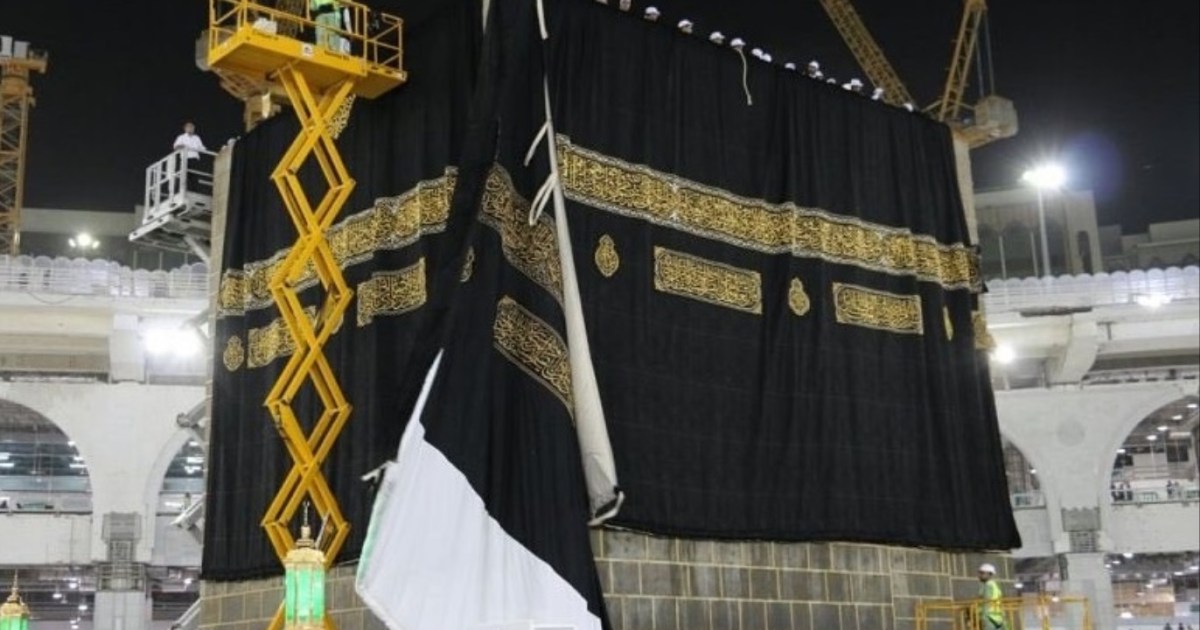The covering of the Kaaba is raised every year at the beginning of the month of Dhu al-Hijjah by several metres, then it is lined with cotton in preparation for its replacement with a new covering on the eve of the Day of Arafa, as if the Kaaba is wearing the new covering with the Muslims in celebration of Eid with them.
This custom began in the Farewell Pilgrimage, when the Prophet, may God bless him and grant him peace, replaced the covering of the Kaaba with Yemeni fabrics, followed by the Rightly-Guided Caliphs, and this has continued to this day.
The covering of the Kaaba
The manufacture of the covering of the Kaaba began in the era of the Prophet, may God bless him and grant him peace, and the Rightly-Guided Caliphs, from Yemeni fabrics until the era of Muawiyah bin Abi Sufyan. The second is in preparation for Eid al-Fitr.
The covering of the Kaaba was made from the best Damascene fabrics and was sent to Mecca from the Kiswa area in Damascus, and from here it was called the covering of the Kaaba, and soon it moved to the Egyptian city of Tenis, where the luxury clothing industry of silk began and its embroidery, and the caliphs duel in it where Harun al-Rashid clothed The Kaaba twice a year, so al-Ma'mun added to it and clothed it 3 times a year.
Adhere to the honor of manufacturing cladding
The Egyptians considered the honor of making the covering of the Kaaba as their own, and no one should dispute it.
In the year 751 AH, the King of Yemen made a livery from his country, and attempts were repeated by the Persians and Iraq, but the rulers of Egypt insisted on continuing to manufacture it.
In that year, the good king Al-Nasir bin Qalawun allocated a waqf in Egypt to cover the Kaaba once a year, and this law was applied regularly until the era of Muhammad Ali, when a political dispute broke out due to the methods of the celebrations of the Kaaba covering convoy, and Egypt stopped manufacturing the Kaaba covering for a period of more than 6 months. Years.
But in the year 1233 AH, the House of the Kiswa Industry was established in Cairo, but it stopped making the new kiswa since 1381 AH (1962 AD), when the Kingdom of Saudi Arabia took over.
Establishment of the complex of the covering of the Kaaba
King Abdul Aziz Al Saud, following a political dispute with Egypt, ordered the establishment of the House of the Kaaba Kiswa (1346 AH / 1927 AD), and this house was provided with weaving and embroidery machines that are updated every year.
This house contains more than 200 workers, and it produces the outer and inner covering of the Kaaba, and the inner covering of the honorable Prophet’s Chamber, and it uses the finest types of threads in the world, which weigh 670 kilograms, in addition to wires and threads of pure 24 carat gold, weighing up to 120 kilograms , and others of silver up to 100 kilograms.
The cost of covering the Kaaba exceeds 20 million Saudi riyals, equivalent to $ 5.3 million, making it the most expensive garment in the world.
Where does the old cladding go?
The old kiswa is currently handed over to a committee of the Saudi government, which cuts it into small pieces, and then distributes them as gifts to dignitaries, states and embassies in the Kingdom of Saudi Arabia.
It is displayed in the Ulu Mosque in the Turkish city of Bursa dating back to 1517, and it is in the same place where Sultan Selim I deposited it, as he obtained it from Egypt after the Ottoman conquest. It is the oldest complete covering of the Kaaba in its complete condition in the world.
Egypt is preparing to display part of the covering of the Kaaba from last year in the Museum of the new administrative capital, and also displays parts of the old cloth in the textile exhibition in Al-Moez in Cairo from time to time, and the museum displayed last year two pieces of the covering of the Kaaba in green and black, dating back to the end of the Mamluk era and the beginning of In the Ottoman era, the green was part of the covering of the honorable Prophet’s chamber, and the black one was part of the covering of the Kaaba, and in our time there is an old kiswa in the house of the kiswa industry, which was established in Cairo in 1233 AH.

